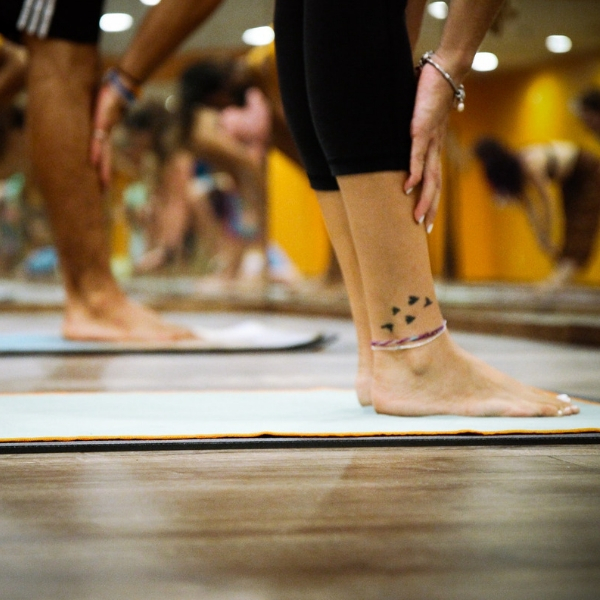08 Jun Why You Need Functional Range Conditioning In Your Life

Most of us want to be stronger and more flexible. Hence we start to come to yoga. Plus to finally touch our toes or pretzel ourselves into fancy poses. Not all bodies are made to bend in specific ways though; thus, you walk out with an injury rather than touching your toes. In order to increase your chances of touching your toes, you would need to learn how to improve your active mobility, stability, and strength of your spine and hips in order to get into this position. That’s when Functional Range Conditioning comes into play.
We take you through what Functional Range Conditioning is and why we incorporate elements of it into our daily routine. The end goal of FRC is increased mobility, joint strength and body control. In previous posts, we already touched on the importance of incorporating functional movements into your asana practice and elaborated on the critical focus of functional yoga, which is is extending mobility rather than flexibility. Power Living has updated and elevated its powerful and transformational Yoga Teacher Training to new heights and incorporated functional movement exercises into its training modules.
Before we get into what Functional Range Conditioning is and why it is too important to be overlooked, let’s quickly recap on the difference between flexibility and mobility.
Flexibility vs. Mobility.
Flexibility is the ability of a muscle to lengthen. Some people also refer to it as our body’s ability to be bent. Sometimes we use our hands to bend a bit deeper, which can lead to injury if we push your body too far. You are not necessarily creating strength of movement or joint stability. It’s passive.
Mobility, on the other hand, is the ability of a joint to move actively through a range of motion. It is the ability of your body to bend itself, which might not be as deep of a stretch as you want it to be, but it’s a lot safer on your joints and hence injury-free.
The aim is, to decrease your risk of injuries when moving your body under load, which is what you do when you move through your yoga asanas or while lifting weights. To achieve this, you need to improve your active mobility, stability, and strength in your end ranges. It will not only make you stronger but will also increase your tissues’ load-bearing capacity. That’s when Functional Range Conditioning (FRC) comes into play.
What is Functional Range Conditioning?
FRC is end-range strength and control training for your joints based on scientific methods and research. It was developed by world-renowned musculoskeletal and human movement specialist Dr Andreo Spina.
Functional Range Conditioning is designed to progressively convince our brain to release its protective stronghold on tissues at the cellular level. For example, instead of letting you drop into full splits and hence possibly tearing and injuring everything on the way down, the brain creates a painful stiffness telling you to stop. Our brains naturally halt movement when it perceives it as a threat. FRC is now acknowledged as one of the safest and most effective way to increase your mobility.
When we train mobility, we use the muscles involved in that movement to make it happen, thus strengthening the muscles that support the joint. That is what defines functional training. Functional Range Conditioning uses a variety of exercises to aid us in increasing our active mobility. It works by systematically expanding your body’s ranges of motion while simultaneously teaching the nervous system on how to control the newly acquired ranges. You train your passive flexibility so that it’s converted into usable, functional mobility.
The foundation of the Functional Range Conditioning training to achieve increased mobility and an insightful tool to assess your joint health are Controlled Articular Rotations (CARs).
What are CARs?
CARs are incredibly useful in terms of improving your strength even at your outer range of motion. CARs exercises consist of active circular joint motions at the outer limits of articular motion. A controlled articular rotation is an active, rotational movement at the threshold of a joint’s range of motion. You can perform CARs on almost any joint in your body, and you should preferably incorporate them into your daily routine. Consistency is critical here, as your joints need to move to stay healthy. If you don’t continue to actively move your joints at their entire available range of motion, your nervous system assumes that you don’t need that range of motion. Hence it slowly disappears.
The goal of CARs.
The goal of CARs is to use the whole range of motion of a single joint in a controlled and mindful way. That means a slow and steady rotational movement of the muscles that use that particular joint you are rotating. And only that isolated joint. Nothing else. To promote articular independence, you tense all of your joints/muscles except the one you are moving. Sounds pretty simple at first, but it can be quite challenging, especially when you start.
Resist the urge to create more momentum and learn to hold yourself accountable for not accidentally “cheating” by using any movement or range of motion from the surrounding joints or areas. It can help to practise your CARs in front of a mirror or perhaps imagine your body is concrete, except that one joint which can freely move. You will experience some joints move worse than others, do these more often. After some time, you should experience a slowly increased range in motion.
Each time you practice your CARs try to expand your circular rotations. Thus improving control in the outer limits of your usable range. Thus enhancing the adaptability of your tissues and aiding in joint health, integrity, and protection. You can increase the intensity of your exercise by increasing the resistance through the air. Imagine you are pushing through the thick air, which will ultimately improve muscular and neurological control. However, please do not continue training when you experience any pain or pinching.
Make joints work like joints.
In summary, CARs are potent in maintaining joint health and assess your current ranges of motion. But the expansion of the range of motion is found through PAILs and RAILs. Not through more “forced” stretching, foam rolling or massage. PAILs and RAILs are training protocols designed to increase range of motion by combining strength and stretching. The goal here is to get the brain to utilize as many motor units as possible to achieve a specific movement. What these exactly are and how these exercises look like, will be covered in one of our upcoming posts.
All in all, the basic premise of Functional Range Conditioning is to capture passive ranges of motion in the end range and make them more active. It’s there to improve your body’s ability to do anything you want to do with it. You can use it for specific interventions or broader explorations of your body’s potential. You don’t need to be the most flexible person. Your aim is to have active control over movement. That, along with daily mobility training for joint health is helping to keep your body healthy. And most importantly, injury-free. All we want is to make joints work like joints.
Written by the Power Living team



